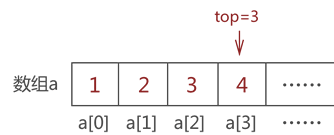顺序栈,即用顺序表实现栈存储结构 在顺序表中设定一个实时指向栈顶元素的变量(一般命名为 top),top 初始值为 -1,表示栈中没有存储任何数据元素,及栈是"空栈"。一旦有数据元素进栈,则 top 就做 +1 操作;反之,如果数据元素出栈,top 就做 -1 操作。



//元素elem进栈,a为数组,top值为当前栈的栈顶位置 int push(int* a,int top,int elem){ a[++top]=elem; return top; }
top 变量的设置对模拟数据的 "入栈" 操作没有实际的帮助,它是为实现数据的 "出栈" 操作做准备的
//数据元素出栈 int pop(int * a,int top){ if (top==-1) { printf("空栈"); return -1; } printf("弹栈元素:%d ",a[top]); top--; return top; }
#include <stdio.h> //元素elem进栈 int push(int* a,int top,int elem){ a[++top]=elem; return top; } //数据元素出栈 int pop(int * a,int top){ if (top==-1) { printf("空栈"); return -1; } printf("弹栈元素:%d ",a[top]); top--; return top; } int main() { int a[100]; int top=-1; top=push(a, top, 1); top=push(a, top, 2); top=push(a, top, 3); top=push(a, top, 4); top=pop(a, top); top=pop(a, top); top=pop(a, top); top=pop(a, top); top=pop(a, top); return 0; }